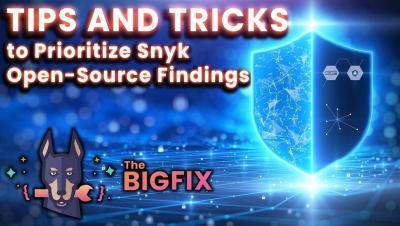Security | Threat Detection | Cyberattacks | DevSecOps | Compliance
Vulnerability
Tips and Tricks to Prioritize Snyk Open-Source Findings (feat. Chris Walz) - The Big Fix 2023
Demo - Prioritize Vulnerabilities that Matter
Fixing half a million security vulnerabilities
Hackathons are well known among software development teams for driving innovation and collaboration. So, what if we applied that model to cybersecurity to improve an organization’s application security posture? That would be a dream come true for any CISO and security practitioner — and is exactly what we set out to do at Snyk in February 2023. Check out some of the funniest moments from our panels.
Snyk in a galaxy far away
In honor of May the 4th, we’re featuring a narrative from an Imperial trooper in a faraway galaxy as he reflects on his organization’s worst day and how it could’ve gone differently. Don’t get me wrong. I’m still proud to work for one of the most formidable organizations in the galaxy. But as most of you probably know, we’ve recently hit quite a setback. Our higher-ups decided to build a space station.
Run Faster, Runtime Followers
Recently, there has been a flurry of announcements claiming to have what we call Runtime Insights, the ability to prioritize vulnerabilities. Here are two examples: I can confirm that this approach works, and it works very well. It substantially decreases the number of vulnerabilities that a team has to manage, sometimes by a factor of 100 or more! How do I know it? Because Sysdig invented this approach.
Patch now! The Mirai IoT botnet is exploiting TP-Link routers
Businesses should patch their TP-Link routers as soon as possible, after the revelation that a legendary IoT botnet is targeting them for recruitment. The notorious Mirai botnet, which hijacks control of vulnerable IoT devices, is now exploiting TP-Link Archer AX21 routers to launch distributed denial-of-service (DDoS) attacks.
Zero day remediation tips: Preparing for the next vulnerability
Businesses increasingly run on software, which, unbeknownst to its developers, can contain vulnerabilities that attackers often discover and exploit before a patch is available. This makes zero day attacks inevitable, but you can reduce their impact in your network and across your supply chain if you’re prepared to act fast.
A Mere Five Percent of Vulnerable Enterprises Fix Their Issues Every Month: How to Help Them Do Better?
Software vulnerabilities are one of the leading threats to an organization's cybersecurity posture, yet recent research from Bitsight reveals that enterprises affected by software vulnerabilities resolve them at a typical compound rate1 of only about 5% per month compounded continuously. However, there is evidence of much faster remediation for certain classes of vulnerabilities.










